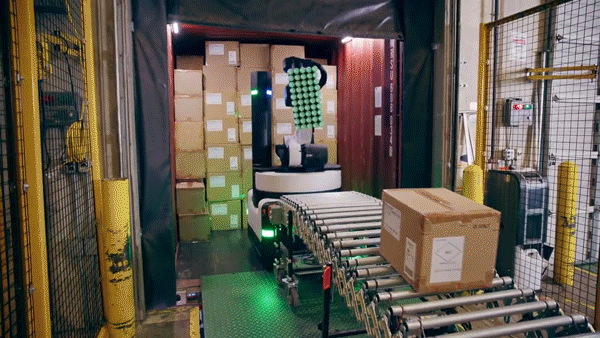Boston Dynamics Stretch robot can unload 350 boxes per hour
Boston Dynamics and DHL's new robot is a hyper-efficient warehouse wor
For all their forklifts and conveyor belts and automatic sorting systems, many warehouses around the world could not operate without a person at a loading bay pulling boxes out of the back of a truck. The hand loading and unloading of boxes, as antiquated as it sounds, is commonplace in shipping for industries ranging from groceries to apparel, to the return operations for most consumer goods.
“That’s a very manual intensive job, and one that’s not well-liked by many,” says Sally Miller, global digital transformation officer for DHL Supply Chain, the world’s largest third-party logistics company. Facing a labor shortage and high turnover in these kinds of warehouse jobs, DHL Supply Chain turned to robot maker Boston Dynamics to come up with a solution.
Together, they’ve co-designed Stretch, a new mobile robot with a suction cup-covered arm capable of picking up and moving 50-pound boxes from the backs of truck trailers and into warehouses. In development for several years, the first two Stretch robots have just been deployed at an apparel company, which DHL Supply Chain declined to name, and about six more will be sent to other warehouse sites over the next three or four months.
Stretch is the first robot that Boston Dynamics has purpose-built for a specific set of applications, according to Kevin Blankespoor, the company’s senior vice president and general manager of warehouse robotics. His is a title that lays bare the potential Boston Dynamics sees in logistics. Previous robots built by the company, including the humanoid Atlas and the dog-like Spot, have found use in industries ranging from utilities to construction to law enforcement. Stretch will likely be of use in a variety of settings, but Boston Dynamics isn’t rushing to adapt it to other tasks or industries. “We’re so excited about the warehouse market that were solely focused on that right now,” Blankespoor says.
According to DHL, there’s huge demand for this type of technology in logistics and warehousing. The rise of e-commerce has caused a boom in the amount of smaller shipments, according to Brian Gaunt, senior director of accelerated digitalization at DHL Supply Chain. Instead of a forklift-able pallet of beer cans or bike wheels, a growing proportion of what’s being shipped are single cases of a specific kind of pants, or single packages fulfilling one-off orders from online sales.
“There’s a lot of product that’s brought into warehouses and shipped out in these quantities,” Gaunt says. “There’s not a ton of technologies that are dealing with that unit of measure.”
Stretch evolved from an earlier warehouse-focused robot called Handle, a two-wheeled bot that could pick up boxes from a pallet, carry and place them on warehouse shelves. The machine was adept at picking up boxes and even combining oddly shaped boxes into neat stacks on pallets, but Blankespoor says the speed couldn’t compete with that of human workers.
So the concept was streamlined. Working with DHL Supply Chain to better understand the speeds, movements and loads required by typical warehouses, Boston Dynamics adjusted the bot’s design. Instead of unloading boxes and carrying them all around a warehouse, the designers optimized Stretch to reach into the depths of a truck trailer, pick up a box, turn around and carry them to a nearby conveyor belt or forklift. Blankespoor says this is still a novel offering. “If you look around at the state-of-the-art in robotics, you won’t find much, if anything, where there’s really mobility and manipulation together,” he says.
Stretch can unload an estimated 350 boxes per hour, a rate which DHL expects to improve as the robot’s machine learning algorithm and computer vision gets better at understanding the puzzle of trucks stuffed full of randomly sized boxes. This rate took years of iterative design to achieve, with Boston Dynamics repeatedly testing their robot-in-development at DHL Supply Chain facilities to improve its speed, the efficiency of its battery, and the hit rate of its suction cups getting a solid grip on the first try.
Capable of moving a box roughly every 12 seconds, Stretch is likely to far outperform a human doing the same repetitive labor, which raises the question about just how many jobs it will eliminate. That’s unknown until it happens, but the addition of robots into workplaces can lead to human workers being ousted. An MIT study looking at data from 1990 to 2007 found that each robot added to companies in the manufacturing industry ended up replacing an average of 3.3 workers nationwide. Miller at DHL says Stretch will help warehouses operate more smoothly without forcing humans out of their jobs. The people who might currently be standing at a loading bay lugging boxes out of a truck “can do something else that is less labor intensive and more enjoyable and value added,” she says. They may even find themselves working alongside the robot. “We’ve got a whole new job category of people who resolve issues that robots run into.”
Blankespoor at Boston Dynamics expects Stretch to become even more useful in warehouses going forward, with new software under development to enable it to focus on both unloading and loading, as well as the creating pallets from loose boxes. The company will continue to collaborate with DHL to understand the needs of warehouse workers and the logistics industry, and the potential for new tools to help increase operations. “That’s where we’re going to focus on scaling for the next few years,” he says. “It’s kind of early days in warehouse robotics.”



